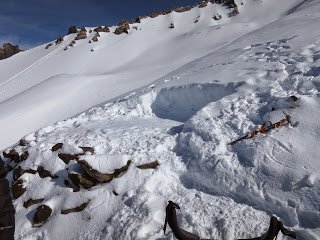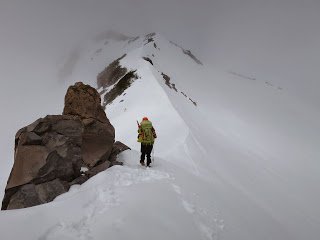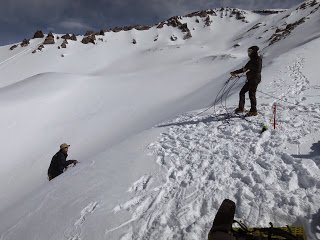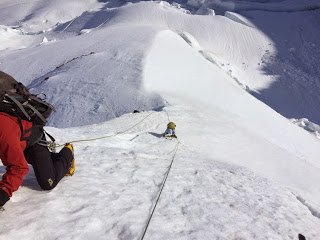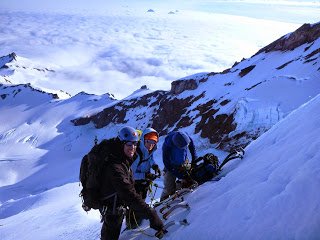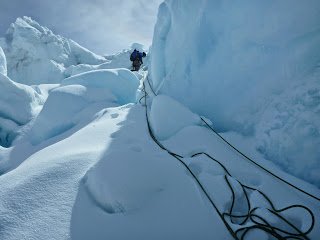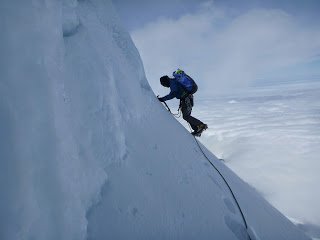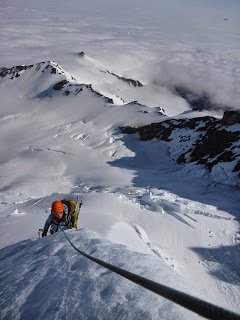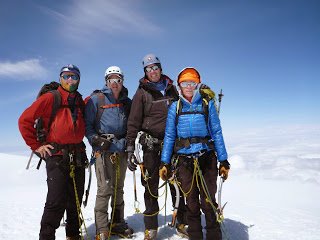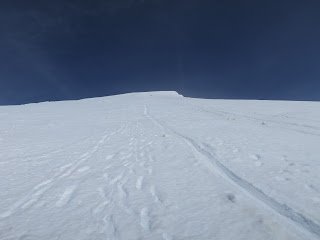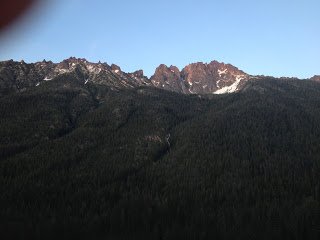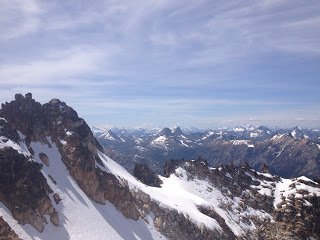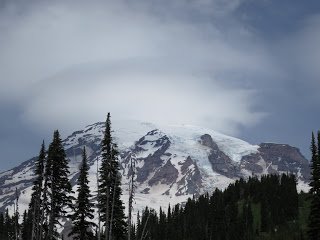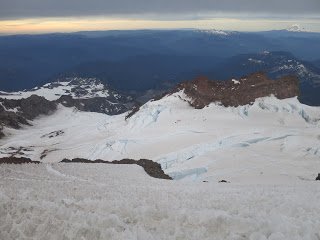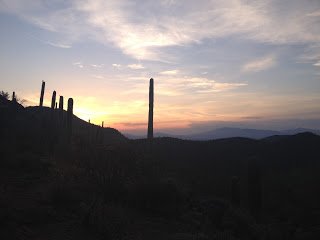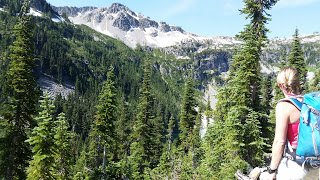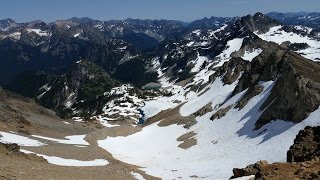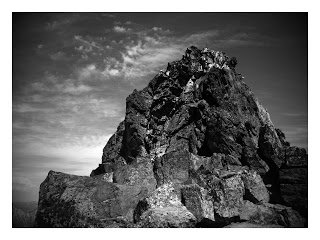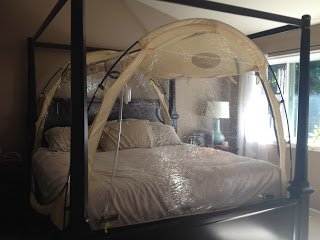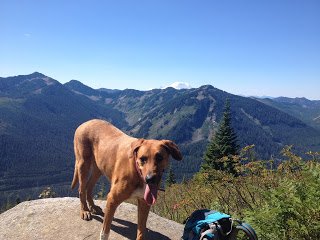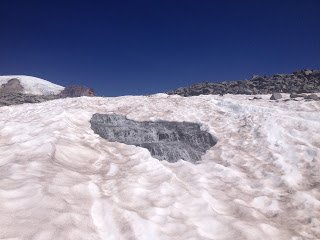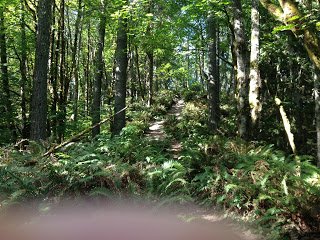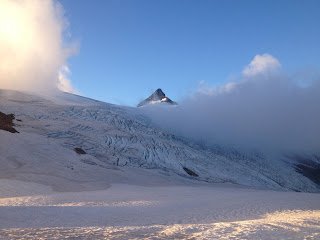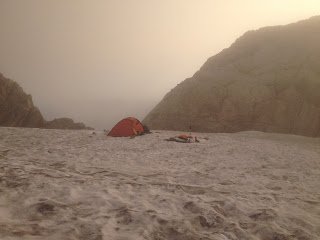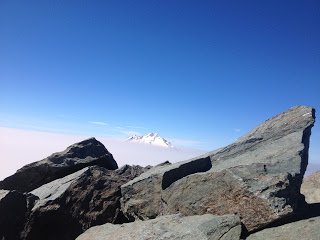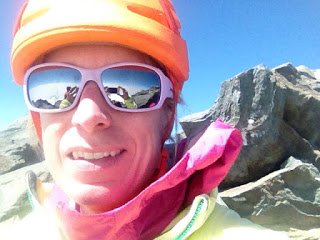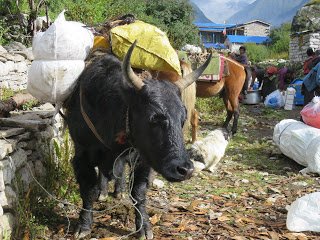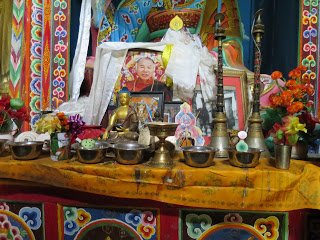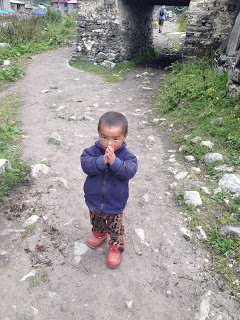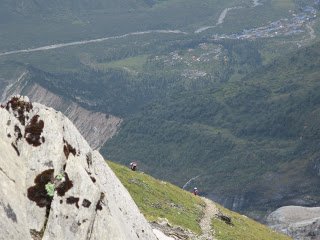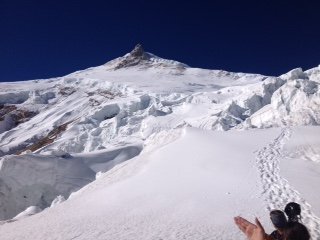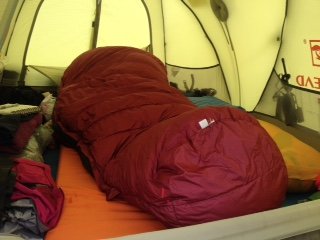Manaslu
Nepal - 26,781 feet ~ 8,163 meters
Overview
Every ambitious mountaineer eventually finds their way to the Himalaya . After successfully climbing some of the world's tallest peaks, I felt like the time was right to climb above 8,000 meters. After many interviews with fellow mountaineers and weeks of online research, I felt like I had found a peak that would challenge me and still be within my reach.
Manaslu is the eight highest mountain in the world, its narrow summit is 26,781 feet (8,163 meters) above sea level and it is known for wet conditions, which sometimes cause its upper flanks to be avalanche prone. Manaslu is typically climbed in the autumn, after the monsoon season has ended, making it even more desirable because I could train in the summer instead ofthe dreary Seattle winte
Training Blog
January 2, 2015
Hello 2015!
I've enjoyed two months "off" from training since returning from summitting Kilimanjaro in late October. This was fortunate because it has taken that long for all of the free-loading Tanzanian bacteria and parasites to vacate my intestines. Yikes, those buggers are resilient!
To kick-start my training plan for Manaslu, I have been reading Steve House and Scott Johnston's new book Training for the New Alpinism. I agree with the premise of this book; which is that historically climbers have trained for climbing by climbing. While this might be effective if you're a professional mountain guide, the rest of us need more guidance. Which is just what I've found so far in Steve and Scott's book. I am also very intrigued by the notion that you don't have to get your ass kicked by every workout to make progress, as this is the formula that I have painfully followed so far when training for big climbs.
January 26, 2015
It has begun. I've become so intrigued by the premises in Steve and Scott's book that I've made arrangements for them to design a training plan for me. I initially thought that I could do it on my own based on the details in the book, but in the end wanted more guidance from the experts.
The training plan that they've created for the first seventeen weeks of my preparation includes a heavy focus on building my aerobic base. I'll focus on increasing the volume of aerobic training at heart rates at or below my aerobic threshold in order to train my body to sustain the level of activity that I will need to comfortably climb Manaslu. This low-intensity training will be coupled with strength training to build the muscular power that I will need as well.
February 1, 2015
First week of training complete! This is just my transition period from non-training mode to training, so it's been relatively easy. I logged five hours of cardio, paying close attention to my heart rate, and ensuring that it stayed below my aerobic threshold. Even though I don't enjoy running on a treadmill, it's easier to control my heart rate on predictable terrain. So, I've befriended Netflix and am making the best of it.
In addition to cardio, I've started to increase my upper and lower body strength by doing squats, step-ups with moderate weight and pull-ups.
It's already been challenging to work the time into my hectic work schedule, so I've started to just schedule the time each morning by adding it to my calendar along with the countless other meetings.
I've started reviewing my gear. This will eventually lead to near daily gear checks and a general obsession with gear and its weight. I'm torn about whether my super warm Feathered Friends down parka and matching down pants will be sufficiently warm - they're the components of a Feathered Friends down suit - or whether I need to save another $1,200 to purchase a complete suit. I did some on-line research today for women's down suits, which don't appear to exist. I accidentally bought a new wind-proof down parka, though. It was on sale. Maybe Feathered Friends will sew my pants and parka together.
February 16, 2015
Today marks the beginning of week four of my training plan for Manaslu. This weekend, thanks to some unseasonably dry and warm weather in Seattle, I got to put my training to the test by hiking up familiar Mailbox peak for a training hike. I have probably hiked up Mailbox thirty times or so, so it was a good measure of my fitness level, and I have to say that I felt great. Granted, I was only carrying fifteen pounds in my pack, but I made it up in less than two and a half hours with a moderate heart rate that was less than my aerobic threshold, and my muscles didn't feel at all tired.
Today, since it was unseasonably sunny and warm again, I continued my test by enjoying an eight miles run on my favorite trail. Again keeping my heart rate between 130 and 145 bpm, I felt great and really enjoyed some quality time in the woods running with my dog and clearing my head. Hooray for sunshine!
This week will be the last of the transition weeks in my training plan. I'll complete over five hours of cardio and complete my strength and core exercises multiple times before dropping my cardio hours and switching strength exercises next week.
February 21, 2015
What a spectacular winter day for a run on the trails above Lake Chelan! I wrapped up my weekly cardio training with a beautiful 6 mile run on the muddy, snowy trails at Echo Ridge. After 6 hours of cardio this week, I think that I've hit the point where my metabolism has goaded my appetite into an insatiable nag, requiring food every two hours. After a well-rounded dinner on Thursday I ate a bag of movie theater popcorn, a chocolate bar, and a beer. Not good. I either need a chef or a nutritionist to help me ensure that all of my hard-earned hours of exercise don't go to waste. I've heard that fitness is 60% what you eat and 40% what you do.
March 1, 2015
This week was all about cardio. Thanks to an annoying medical procedure, I was only able to do one hour of strength training this week. While I feel incredibly guilty about not completing my planned workout, I have to keep things in perspective and accept that taking a couple of days off to let my body heal is more important.
So I focused on what I could safely do, which was cardio and hiking. Rather than run, I logged six hours on an elevated treadmill, walking at about 3 mph, enough to keep my heart rate between 130 and 145 bpm. And, again this weekend Seattleites were treated to spectacular late winter weather which I enjoyed by hiking up the old Mailbox peak trail in just over two hours with a light pack.
I also spent some time this week planning the next phase of my training plan, which will begin next week when I convert from the transition phase to the base phase. During the base phase I will work on building the cardiovascular and strength base that I will need to successfully execute more climbing specific training later. My base period will last about twelve weeks and each week I will focus on two upper and two lower body exercises and will complete five to thirteen hours of cardio. I'm looking forward to this phase of training because it is more aerobic which I enjoy more that strength training. I'm sad that I haven't practiced yoga for three weeks! I can't remember the last time that happened, but I'm committed to making some time this week!
March 8, 2015
Trail miles run: 16
Sport routes climbed: 19
Pull ups completed: 48
Pounds of fudge eaten: 0.5
Miles hiked: 8
Elevation gained: 3,020
Another beautiful week in Seattle! I am so thankful for brisk mornings and sunny afternoons. Thanks to belated sunsets, I was able to do all of my cardio on trails instead of the treadmill ... yeah! There's something about a quiet trail at the end of the day that blankets me with peacefulness.
I'm still working on my nutrition, maybe that will be my focus next week :)
It was a busy week, but next week I will devote even more time to training when I increase my cardio time to 8 hours, I'm actually looking forward to it!
March 15, 2015
This week I started vary my cardio time, dividing it into one long session with my heart rate near my aerobic threshold, and shorter sessions with my heart rate 10 - 20 bpm lower. I was fortunate that the weather cooperated for one of my short cardio sessions - a trail run on a beautiful spring day with song birds and bugs that buzzed and crawled after ending their winter naps. The rainy Seattle weather returned today; though, just in time for a hike up (and run down) popular Mt. Si. Fortunately the bad weather kept away the normal crowds of people, but despite Gor-Tex, every part of me was soaked.
I guess that today's hike should also give me some credit in the mental toughness category. Which, was timely because I just finished Steve House and Scott Johnston's book Training for the New Alpinism. The last chapter of which outlined the importance of mental discipline during the training process as a means for preparing for big climbs. While hiking up Mt. Si on a cold, rainy, windy day is nothing compared to the conditions on Manaslu, it's still a good feeling - and important - to push through uncomfortable circumstances.
It's going to take a while for my shoes to dry ...
March 22, 2015
I've officially started my part time job ... mountaineering trainee. I struggled this week to fit in 10 hours of cardio plus four hours of strength training, among work meetings, doctors appointments, grocery shopping, and time with friends. As usual, I compromised sleep in order to squeeze it all in. But, I feel good. Yesterday I hiked up Mailbox peak - 4,000 feet of gain in less than 3 miles - decorated with slimy mud and slick tree roots. Although my pack was light, I felt good - really good. I made it to the top in less than two hours, despite the blowing snow that greeted me above the tree line. Should have checked the weather ... and worn boots.
I jogged down the new Mailbox trail in order to keep my heart rate within the target range and was back at the car in less than four hours.
Next week I'll cut my training time by about 25 percent to give my body a chance to recover, this means only one strength workout and only 6 hours of cardio.
I jogged down the new Mailbox trail in order to keep my heart rate within the target range and was back at the car in less than four hours.
Next week I'll cut my training time by about 25 percent to give my body a chance to recover, this means only one strength workout and only 6 hours of cardio.
March 29, 2015
Yeah for a light training week! Before work on Monday I completed my only strength session, followed later in the week by 7 hours of cardio divided between three workouts. I capped it off today by hiking up and running down Chelan Butte one and a half times. Happily skipping over snakes sunning on the dusty trail.
April 5, 2015
There are times in life when you're reminded that you're not in control, and that despite immaculate planning, things can change in dramatic ways. Breast cancer was not on my list of things to do this year ... or ever. But this week I dealt with my diagnosis by having a bilateral mastectomy. Needless to say, it has put a damper on my training plans.
Despite a hectic week of doctor's appointments and difficult decisions, I finished most of my scheduled training before Thursday's surgery, and completed the alpine combine the morning of surgery so that I would have a means of measuring how much my fitness had declined when I'm able to resume training. By Thursday evening, my exercise goal was to walk around the ICU, pushing my IV pole.
My focus now is to recover quickly, and stretch my chest and arm muscles in order to regain their full range of motion as quickly as possible. I'm hoping to begin to increase my heart rate by walking on an incline (and keeping my arms still :)) next week.
Mostly, I'm determined not to let cancer determine my goals.
April 10, 2015
I don't think it was Nike's intention, but the pockets in their running pants are the perfect size for my post-surgical drains, which really are kind of disgusting little things to be carrying around with me everywhere that I go, but since they're attached to a foot of perforated tubing embedded in either side of my chest, I hardly have a choice right now.
I've met my goal of completing five hours of cardio workouts this week, including a two hour workout today. So far I've felt really good after, I'm hoping just to maintain my cardiovascular fitness by logging the same number of hours pre-surgery at the same heart rate. As for strength training, I haven't been able to do much, so I'm primarily focused on stretching and improving the range of motion in my arms.
April 13, 2015
If Colin Haley (left), Alex Honnold (middle) and Mike Gauthier (right) raced on a Tyrolean traverse, who would win?
Since I'm unable to climb right now, I've got to find another outlet ... Saturday night's Breakthrough event hosted by The Mountaineers was the perfect fix! What a great way to inspire mountaineers to explore, conserve, and learn about the natural world.
Next weekend, I'll be back in the mountains!
April 15, 2015
I've continued my cardio workouts, planning to build on last week's 7 hours by accomplishing 10 this week. I'm still not cleared to run, so I've been putting in the time on the treadmill, elevating it and adjusting the speed to keep my heart rate between 130 & 150 bpm while walking. Two hours on a treadmill is tough, especially when it's sunny outside, but I've been sticking to it in the hopes that next week I can begin trail running again.
Yesterday I also tested my body to see if I could tolerate any of the strength training that I was doing pre-surgery. Pull-ups and most of the upper body exercises are still on hold, but it did feel good to do squats with 85% of my pre-surgery weight and box step-ups with very light weight in my new weight vest. I'm still adjusting its fit on my chest to be sure that it's not painful, but I think that it will do the trick until I'm able to hold weights or wear a weighted pack.
April 21, 2015
Hooray for beautiful, warm Spring weather! This weekend Seattlites we rewarded with uncharacteristically nice weather, perfect for my first real hike. I feel very fortunate that I have been able to walk from my house to in a beautiful wooded park during my recovery. Spending time exploring in the woods, listening to the birds, noticing small plants just waking up from winter, feeling the rain and occasionally sun on my skin was probably the best medicine I could have.
But now it's time to switch gears and elevate my heart rate!
We hiked up Mailbox peak in just over two hours, a respectable pace, and I know that I could have pushed harder if I needed to. There's an asterisk on this statement; however as I was not carrying a pack, which makes a significant difference. I still need to work up to carrying one since my incisions are in the direct path of its shoulder straps.
Descending Mailbox's twisted, muddy roots and loose rocks is always a challenge, and for some reason I decided that forgoing a hiking pole would be best, which I regret. I found myself being overly protective with every step. Slipping really is inevitable, and when the rocks under my feel began to roll and it happened I landed on my hip, instinctively outstretching my right arm to brace myself. I was truly fine, and I realized just how protective I had been, it was probably good for me to fall just to know that it would be ok, and it was.
April 26, 2015
Today I am incredibly thankful that my workouts this week were 99.9% equivalent to my pre-surgery workouts. The only slight modification being pull-ups and chin-ups. I'm doing them with the assistance of a thick rubber band which probably reduces the load by 30 pounds or so. I've felt really good after each workout, and have begun working more closely with Scott Johnston, co-author of Training for the New Alpinism. Scott has been incredibly helpful at designing workouts that push me just the right amount. I'm finding that my body is in better shape than my mind when it comes to certain exercises, like pull-ups. I know that it's completely irrational, but I have this vision of my arms detaching from their sockets like a Saturday Night Live sketch. I really didn't expect to have confidence issues, so I'm taking it slow but still pushing myself.
Today I hiked up the snow covered trail to the lookout atop Granite Mountain. There was much more snow than I expected, and it felt really good to be kicking steps on steep snow again!
Next week's goals are to resume trail running, wear a pack, and do pull-ups without assistance!
April 28, 2015
Over the past two weeks my workouts have consisted of a warm up that included ten minutes of cardio and a few core exercises, followed by two upper and two lower body exercises using weights near the upper limit of my ability. These 'max strength' exercises are designed to build strength in the key muscles that I will need for climbing without increasing bulk. That last part is important because usually somewhere around the middle of my training regimen, my quads are too big for my pants.
Today I completed the first max strength workout of the week, and I am thrilled that I was able to complete all exercises, even push-ups and pull-ups without any modification! Ha! Take that cancer!
Tomorrow I'm planning my first trail run - even though there is a 60% chance of rain!
May 2, 2015
Cancer-free for one month!
May 8, 2015
What a beautiful evening to hike up the cable line trail and run down west tiger 3 (twice). I admit that it feels funny to not be carrying a pack on these training outings, normally at this point in my training plan I would be lugging around 30 or 40 pounds everywhere I go. I thoroughly understand the look of pain on the faces of people on the trail that are burdened by heavy packs, training for climbs on Denali or Rainier this summer. I don't blame them for the dirty looks that they probably unconsciously throw my way as I pass them, encumbered only by a water bottle and cell phone. I feel their pain, and know that soon I will join them.
May 18, 2015
Finally back on a big mountain! I took advantage of a work trip to San Francisco to spend some time this weekend with friends on Mt. Shasta. We chose Sargent's Ridge for our approach. First, we gained about 1,000 feet in the forest, stepping over fallen trees on the soft dirt that was covered with snow just a few weeks ago. This was the first time since my surgery that I've carried a big pack, and my leg muscles strained occasionally with the added 40 pounds. I was a bit concerned that the weight and position of the shoulder straps would be painful, and there were a few times that my chest felt sore. I took a private second during a break to check things out - all looked good, so I pressed on.
After about two hours we were on Sargent's Ridge - time to focus! The ridge was mostly snow-covered with occasional rocks that we navigated meticulously.
Between clouds I watched other climbers making their way up the popular Avalanche Gulch. I was thankful for the solitude on the ridge. We made our way up 10,500 feet and spent two hours making camp, including a very precise tent platform complete with a retaining rock wall.
Overall, I felt great after our climb on Mt. Shasta. A little sore for sure, but mostly from the weight in my pack, not from surgery. I feel completely thankful for recovering so quickly and being strong enough to be back in the mountains and climbing with confidence.
May 26, 2015
After feeling so good last week on Mt. Shasta, I decided to re-join a group of friends climbing the north ridge of Mt. Baker this weekend.
We had been planning this trip for months, and I was excited to try a technical climb and learn - through the aid of the American Alpine Institute - some ice climbing skills. I'd even used the climb as an excuse to buy ice tools and screws! So I was disappointed when cancer seemingly thwarted my plans. But, early last week I decided that since I had been feeling strong, and hadn't experienced any set-backs in my recovery, I should at least try. If I felt bad after the approach, I could just stay in camp while the boys went for the summit. I was so glad that I went! Aside from my legs feeling wobbly under the weight of a 46ish pound pack on the rocky trail leading up the Hogsback, I felt great!
The weather was warm and dry on Friday afternoon when we started out from the Heliotrope Trailhead, after a couple of hours we had hiked above the tree line to the start of the Coleman Glacier where we made camp.
After spending several hours on Saturday learning basic ice climbing techniques, I felt ready to give it a try. We set off for the summit at 2am on Sunday morning, the weather was clear and crisp with just a light wind. We were hoping for 4 or 5 snow or ice pitches before reaching the summit plateau and strolling casually to the top. If all went well, we'd be back in our tents before the threat of afternoon thunderstorms. That's not exactly how it played out.
We climbed for a few hours in the dark on the Coleman Glacier, navigating crevasses in increasingly steep snow. By the time the sun rose, the angle of the terrain had increased to somewhere between 60 and 70 degrees, and it felt like a good time for some protection.
After a couple of snow pitches, we gained the ridge and the terrain changed. I looked up at the wall of ice above me and honestly thought that it looked like fun ... type 1 fun. The first few moves were straightforward, vertical movement. Then I came to an arete. Hmmm ... how exactly was I supposed to move myself and this 20 pound pack around the corner? The ice on the other side of the arete was in the sun, so I guessed that it would be better than the flaky stuff that I was feebly clinging to. So I gave my right tool a swing in the general direction of the opposing side, and with relief watched its adze reverberate when it struck solid ice. Somehow I maneuvered myself onto the opposite side. The ice was; in fact, better, but the angle of the slope was not, and I felt my heart rate increase as I struggled to keep my breathing under control. I made it to the first belay stance after a few minutes, and kicked my feet wildly into the 70 degree slope in order to make a horizontal platform for them. So much for type 1 fun.
This routine continued for several pitches that alternated between snow and ice. And, they did get easier as I got slightly more comfortable with my body's movement. By the fourth one, I could speak in complete sentences without stopping to catch my breath when I got to the belay stance.
About this time, I looked at my watch and realized that six hours had flown by. We should be close to the summit plateau by now, but by the looks of the terrain in front of me, we were nowhere close. Although we were moving efficiently, we had to kick steps most of the way on the snow slopes, which slowed our pace. We had a long way to go.
When we arrived at what should have been the final ice pitch, it was obvious that a snow bridge had broken recently, and the preferred route was littered with snow and ice debris. The debris was unstable, so we'd have to find another way around.
After testing our options, we chose to climb around a corner, which lead to one last snow pitch. This proved to be more difficult than it sounded. At the base of the corner was powdery snow which didn't easily consolidate into a stable platform for my feet, and the ice on the corner was blue and brittle. Big, sharp chunks of it sheared off and fell below me just about every time that my tool hit it.
We all made it safely around, ascended the last snow pitch, and finally were able to walk upright across the expansive summit plateau onto the summit.
We descended the non-technical Coleman-Deming route in blazing heat and made it back to camp at 3:30, feeling tired, but really good about an exciting day in the mountains.
May 31, 2015
This week's climb was Mt. Adams. I've climbed the south side of Mt. Adams a few times, most recently three years ago. Always I have done the typical approach and spent the night at the lunch counter. At Scott's urging, I climbed it this time in one day.
The plan was to meet friends at the lunch counter - a rocky area at about 9,100 feet - early Saturday morning. I was really excited for some reason to independently make the trip to Trout Lake and start the climb on my own.
Late Saturday afternoon I left home under bright blue skies and made my way south, enduring the mass of population and strip malls in Puyallup. Gradually the traffic thinned as I drove through the small towns that I'd passed through many times on my way to Mt. Rainier.
I was excited to be on my own. Even before I started climbing, I had a dream of going on a long hike on my own, with just my dog for company. Although I had yet to realize that dream, starting a climb of Mt. Adams on my own was in a small way similar. It felt good to navigate the rutted gravel roads, listening to Tom Petty, stopping to take photos of the sunset and big brown cows licking the spray from a faulty irrigation pipe. No one to grumble at me for misinterpreting cryptic directions. After the small town of Randle I was finally on my own, crowded only by the Douglas fir that lined the road.
At 10 pm I was parked at the trailhead, and set the alarm for 3 am. There were a few others making their Subarus and trucks into sleeping quarters. It was a beautiful, warm night, presided over by a hazy full moon. I debated closing the sun roof of my car because when I stepped outside for a few minutes to confirm the trailhead location, I came back with three mosquito bites, but it's worth the risk to hear the crickets chirp and feel fresh air on my face.
Getting a good night's sleep in a small sedan is not easy, and I tossed and turned for most of the night, eventually moving from the back seat to the front. I was awake before my alarm and ready to hit the trail. At 3:20 I radioed my friends who had spent the night on the mountain to tell him that I was on my way, dressed in shorts and a pink hoodie, I was planning to move quickly in order to stay warm. I instantly remembered a mental note from a few weeks ago to buy a new headlamp. Despite new batteries, my ten year old version was barely providing more light than the full moon. I ate two hard boiled eggs and a ProBar as I moved along the sandy trail, dodging rocks and rolling my ankle multiple times but somehow managing to stay upright.
After being on the trail for about 40 minutes I looked ahead and noticed a light patch on the trail, I wasn't expecting snow so early. After several minutes of sliding in my trail runners, I stopped to add microspikes. The wind began to pick up so I kept moving to stay warm. The snow built but it's brightness improved my visibility. In fact by 4:30, I took my headlamp off since it was providing little more illumination than the slowly rising sun.
My friends and I communicated a few times via radio, and by 5:30 I heard them calling my name from the lunch counter. I was getting colder and gladly dove into a sleeping bag to warm up before I continued my climb. I was surprised that I was shaking, I didn't realize how cold I was. After a doughnut - which I had carried from the trailhead - some warm coffee, dry socks, and another layer of clothes, I was ready to go.
Mt. Adams is a straightforward climb, in fact some would probably argue that it's not a climb since no rope is required. That area between climb and hike sometimes murky to me, but on Mt. Adams there is no crevasse hazard, so I was able to safely move up the mountain on my own. It is also possible to see most of the route from the lunch counter, and I watched small dots thousands of feet above me moving slowly upward. In fact, it seemed like everyone above me was frozen each time I looked up as if someone yelled "freeze!" and everyone stopped moving.
I took a quick break at 10,000 feet, ate half of a ProBar, spotted my friends below me on the snow slope and continued moving up. Although they were moving fast, they were too far below me to wait. I continued moving, focusing on finding the best boot path upward. It felt good to make decisions on my own, accountable only to me. The slog continued to the disappointly false summit, which I reached just before 9. As I narrowed in on the true summit, I was reminded of what 12,000+ feet feels like, it had been a long time since I was at that altitude, and my pace slowed as I focused on controlling my breath.
At 9:30 I was standing on the summit, the wind still blowing hard in my face. I didn't stick around for long as I was wearing all of my clothes and still chilled. In the few minutes that I was on the summit, I heard an excited girl proclaim that this was her first summit and that it felt amazing. I thought to myself that even though this was far from my first summit, it still felt amazing.
June 6, 2015
This week marks the seventh week of my max strength regimen. In mid-April I started squatting 95 pounds, as of this week, I'm up to 120. Best of all, during yesterday's climb my legs didn't feel tired or weak. In addition to squats, I've also been consistently doing pull-ups. Back in April I was doing 4 - 6 assisted pull-ups per set, today I'm doing 3 reps with 15 added pounds. I like progress!
Yesterday I climbed up Silver Star mountain in the north Cascades. It was a beautiful climb, with just the right balance between glacier travel and scrambling. We ascended via the Burgundy col.
I was very happy to encounter only three other climbers the whole day, I was less happy about the endless scree and shifty kitty litter on the descent, but we made it back to the car with just a few scratches and one bloody knee.
June 8, 2015
Lisa: 24 push-ups, 19 step-ups, 25 sit-ups, 16 pull-ups, 19 squats
Murray: 60 minutes of sleeping
June 14, 2015
What an incredible weekend to be in the mountains!
It started on Saturday on Mt. Rainier, I left the Paradise parking lot at 9:30 and started off for Camp Muir on the under warm blue skies, I was carrying a light pack and moving quickly up the rocks and eventually onto the Muir snowfield. Once on the snow, I settled into a quick pace, the sound of my boots in the snow muffled by the drone of a Chinook helicopter searching for a missing climber on the north side of the mountain. It reminded me that while it was a beautiful day, mountains can be dangerous places, especially when you let your guard down.
I continued moving quickly, thanks to firm snow, even under the sunny skies, and made it to Camp Muir at 12:05. A new record for me!
Today with my friend Jeff I traded Mt. Rainier's snow for dust and rock on Granite Mountain. Again a light pack allowed me to move quickly, my legs no longer feeling tired like they had a few weeks ago ... all of those squats & step-ups are paying off! I made it to the top in 1:59 and despite the wind enjoyed view of Mt Rainier and Mt. Adams.
In total, this weekend I gained 8,440 feet in 8.3 miles ... whew! Time for some stretching and a foot massage!
June 21, 2015
Mt. Rainier is probably my favorite mountain, and I endeavor to climb it each summer. So, this week I decided to cap off my training with a Rainier climb.
We got permits to camp an 10,188 foot Camp Muir and made it there with a 40 pound pack in under four hours on Saturday, not horrible time, plus I did stop to change from trail shoes to mountaineering boots on the way. Camp Muir is an interesting mountain setting, and I am always entertained when I stop to people-watch. Invariably, there will be one or two people lying in the dust and rock, too exhausted to move, there is usually also someone trying to make a phone call to advertise their locale, plus a handful of mountaineers bustling around either making or breaking camp.
After a pleasant night with mild weather, we left camp for the summit at 2 am, carrying light packs. The snow conditions were really good -firm but not icy - and we made good time through cadaver gap, across Ingraham flats, and onto the rocky spine called disappointment cleaver. We meandered through the loose rock. scree, boulders, and talus and exited the cleaver just as the sun was starting to light the eastern horizon.
After the rock gave way to snow, we got into a steady rhythm, slowly moving up the mountain. The winds were forecasted to be between 20 & 25 miles per hour, and as we started a long traverse toward Gibraltar ledges, my hands were starting to feel it. My rule when my hands get cold is that I will make an adjustment, and continue moving for twenty minutes to assess improvement, Today I was counting on the sun to warm them, but as soon as it rose, it was concealed by thick, dark clouds. Next I changed to my warmest gloves.
After twenty minutes my fingers were still painfully cold, and a couple of them had been cold for more than forty minutes. I put my head down and kept moving, certain that they would warm up if I increased my heart rate. But I was breaking my rule, and the summit wasn't worth damaged fingers.
So we turned around, and started to descend quickly. It would be thirty more minutes before I could feel all of my fingers. Once I was warm, we could take our time and enjoy the mountain, stopping to marvel at teetering seracs and endless icy crevasses on the way back to camp Muir.
As I was loading our gear into the car a few hours later, I looked back at Mt. Rainier, already planning my next summit attempt. I noticed what looked like the beginning of lenticular clouds forming over the summit. I've been told that lenticular clouds are a sign of high wind and impending precipitation when they sit over mountains. I'm not sure if that is true, but it made me feel better about making the right decision.
June 23, 2015
Beautiful trail run in the desert near Tucson today ... so different from the PNW!
June 27, 2015
Today I braved the sweltering heat to hike/scramble up the south ridge of Black Peak in the north Cascades. Normal people opt to take on the 11.2 mile trip in two days, enjoying stunning views of the three lakes and wildflowers along the way. But since this is training, I made the trip in one 9.5 hour day. Whew!
I made good time to the snowfield and as I made my way onto it, I encountered the first descending climber that I had seen all day. "How was it?" I asked him. He sort of grumbled about loose rock and asked me if I had an ice axe. "Nope." I said and tried to bury my trail running shoes in the snow. "But I have my helmet!" I told him as consolation. Just before Wing Lake, which sits at the bottom of the snow field that I was now standing on, I had cached my boots, deciding that there was no way given the recent heat, that snow would be an issue. I was wrong. So, I put on my helmet and started up, carefully placing my feet in the path of another cramponed climber, and kicking steps when I had to. I was thankful when I made it to the col at the top of the snowfield without incident.
The rest of the route would require scrambling, so I was once again thankful for my trail shoes. I picked my way through the rock, stopping to build extra cairns to assist my descent, and made it to the top and was just a little frightened on the last pitch up a chimney to the summit.
July 2, 2015
"It's ok, I'll sleep in the trunk." I found myself saying illogically as I made plans with friends for a one-day ascent of Mt. Rainier. The plan was to "sleep" in the car for a few hours at Paradise, then start climbing an midnight and be home for dinner. Making the climb in one day would afford us the luxury of carrying light packs and moving quickly.
We started off on the familiar trail which seemed completely different without a parking lot full of cars and people. It felt peaceful to move in the warm night air. Moths flew in patterns in the light of my headlamp and everything felt still and quiet. Under the full moon we made good time to Pebble Creek and stopped to top off our water bottles before pushing to Camp Muir. With the exception of a glissading cowboy - which I still think may have been a mirage - we were alone on the Muir snowfield.
This is where things went awry. Remnants of greasy yakisoba started to torment my partner's stomach and our pace slowed. We weren't able to make it to Camp Muir by our three hour time limit, which was frustrating for us all, but it's a team sport and it just wasn't coming together for us. I'm already planning my next Rainier-in-a-day trip. Hopefully I won't have to sleep in the trunk.
Oh, and I kicked cancer's ass 3 months ago :)
July 4, 2015
Since I didn't achieve my objective on Rainier, I needed to gain some vertical. I opted for a quick hike up familiar Mailbox Peak, making it to the top in just 1:47, which I think is a new record for me. Jeff's time is still 10 minutes better, so I have some work to do! In order to keep my heart rate above 130 bpm, I jogged down the new trail. 4,000 feet of vertical gained and lost in 3 hours and 11 minutes.
July 5, 2015
I leave for Nepal is 7 weeks!!! It's time to transition my training regimen from max strength - low reps with high weights - to muscular endurance. The muscular endurance phase is designed to reach muscular "burn" in about a minute without raising my heart rate above my aerobic threshold (which is now 160 bpm). Achieving muscular burn in this way will increase the endurance of the affected muscles. For my first muscular endurance workout, I started by warming up with a few core exercises (hanging leg raises, L-sits, kayakers, and sit-ups) and did two sets of weighted pull-ups (18#) and step-ups (60#). When I was warmed up, I did one minute each of squats, step-ups, and lunges with a 22.5# weight vest. I'm embracing the burn!
July 12, 2015
I am six weeks from my departure to Nepal, which means that this is the point at which, despite months of training and preparation, I have a mini-panic attach that I won't be ready on time.
So, in order to ease my manic brain, I spent some time this week finalizing my gear. After reading several reviews, I purchased Salewa's speed ascent approach shoes. These are the shoes that I will wear on the hike from Samagoan to Manaslu base camp. My trail runners are great for trail running, but they're really not sturdy enough for long, rocky hikes in wet conditions. Normally, I will slowly break in new shoes, but for some reason I decided to go all in and wear them to camp Muir on Sunday. I don't know why I have a propensity to wear tennis shoes on snow fields this summer, but luckily it worked out this time on Rainier. A big thanks to my friend, Jeff for kicking steps in the icy spots! These shoes rock! My feet weren't sore at all, and with the help of some light ankle gaiters, my feet stayed completely dry in the mushy warm snow on the descent. When I got back to the parking lot, I honestly considered leaving them on! But then I saw my flip flops.
Foot health is a big deal to me. When my feet aren't happy climbing is a lot harder. I am also a little superstitious. Several years ago I started using Tuf-Foot before a big climb. I know that most girls spend money to remove callouses from their feet, but I'm trying to make them resilient as possible. My efforts show, and not in a good way, I could scare small children with my calloused man-feet. Tuf-Foot is technically for horses and sled dogs, but somewhere along the way a crafty human decided to give it a try, I don't honestly know if it works, but I've never been tormented by blisters, so I'm sticking with it.
For training this week I did one muscle endurance workout, using the same weights and exercises as last Sunday, did two runs with my heart rate near 160 bpm for 30 minutes, ran a fun 5k, and hiked on Saturday (10 miles round trip with 5,000 feet of gain) and Sunday (5.2 miles round trip with 4,000 feet of gain). By Sunday my legs were fatigued, and very happy for some recovery and stretches.
July 17, 2015
It's hypoxic time!! For several years I have included hypoxic training in our preparations for big climbs. The idea is that by sleeping or exercising in a hypoxic environment, you build more red blood cells, which carry more oxygen, effectively starting the altitude acclimatization process before even starting to climb. Brilliant! I met some of the Hypoxico crew while climbing several years ago and was really impressed by their technology. Since then I've worked with them to prepare for each big climb.
For Manaslu, I started sleeping at the equivalent of 4,000 feet last weekend. I'm slowly working my way up to 9,000 feet, monitoring my SpO2 each morning when I wake up to be sure that it's not less than 90%. If I increase the elevation too quickly, my sleep quality, and in turn my workouts, will suffer. So, I'm walking a fine line to be sure that I gain the benefits of acclimatization without compromising performance. Plus, getting a crappy night's sleep sucks and leaves me feeling hung over and cranky in the morning. No one likes that. Once I'm comfortable at 9,000 feet, I will follow the mountaineering principle of "climb high, sleep low" and alternate between 9,000 feet and increasingly higher elevations.
Ideally I would have started this whole process a few weeks ago, but since I have been traveling for work, it would have been hard to make much progress.
One weird thing about the tent, which fits over our mattress, is that my cat, Murray loves to sleep in it. By loves, I mean he throws a fit and paws at the walls until we let him inside. And once he's in the tent, he stays there all night. Cats live at high elevations, so I don't think it's bad for him, I think he's just weird.
July 18, 2015
This weekend marked the end of the quick training hikes with light packs that I have been enjoying. On Saturday I hiked 3,000 feet up Granite Mountain with Roxy and 20 pounds in my pack. Roxy spent most of the time looking for shade, and I spent most of the time wishing that my pack was 10 pounds lighter.
Today I decided to discover a new trail near Darrington. The Neiderprum trail steep, solitary and perfect! I hiked up 2,400 feet in 1.8 miles with 25 pounds in my pack. Best of all, I discovered Whitehorse Mountain, which I will definitely return to climb.
Roxy joined me again today, even though she would have preferred to stay home and sleep. We were both rewarded for our efforts with ripe raspberries and blueberries in the warm sun.
The crazy thing about the Neiderprum trail is that it leads the way to the site of a former mining cabin. I can't imagine Mr. Neiderprum coaxing a team of horses up there to build his cabin. Must have been one hell of a mine! I searched around the "flat" area near lone pine pass, but unfortunately couldn't find any remnants.
It was a beautiful, peaceful day in the woods, thanks Mr. Neiderprum!
July 21, 2015
In addition to strength and cardiovascular training, I need to spend some time working on the skills that I will need to safely ascent & descend Mansalu. The skill that believe I need the most work on is aluminum ladder crossing, which I guess isn't exactly a skill, but more like something that I need to be comfortable with. The icefall between camps 1 & 2 will likely involve a ladder crossing or two, so I want to be prepared and able to proficiently cross them. So, how better to increase my comfort level than to practice in the back yard!
I was wearing flip flops on my initial pass across the was ladder, and found it pretty easy, even without the assistance from a ski pole. Turns out adding mountaineering boots and crampons makes it a bit more difficult. The challenge is fitting the aluminum rungs on the ladder between the twelve points of each crampon. I'm going to need a bit more practice to do it smoothly.
August 2, 2015
It's hard to believe that I'll be leaving for Nepal in just 24 days! I feel like it's crunch time ... for the past two weeks I've planned my schedule in order to maximize my time to train while not compromising recovery or - my favorite - sleep! Although, sleep isn't quite as enjoyable in the hypoxic tent.
My training for the past two weeks has consisted of one hard run for an hour, two recovery runs, one muscular endurance session, two or three hypoxic training sessions, and climbing or hiking on the weekend. Whew!
Yesterday I headed south to Mt. Rainier and hiked to camp Muir with a 25 pound pack ... twice. In order to finish my double header before the heat of the day, I started in the early morning. There was still a warm breeze blowing as I started out on the familiar asphalt path and made my way up the rocks to Pebble Creek. Under the full moon, I didn't even need a headlamp. I hadn't been on Rainier in a few weeks, and I was surprised that there was exposed rock almost up to 8,500 feet. As I was trudging along in the moonlight, I heard running water on the Muir snowfield and looked up to see a waterfall exposed in the snow, something I've never seen before at that location. It's hard to believe how much snow and ice has melted on Rainier this summer, it feels like a completely different place. Things were quiet at camp Muir during my first visit since all of the climbers were on their way to the summit, I watched the horizon start to lighten for a few minutes, then started down.
I began my second trip to camp Muir at 6:30 am, there were just a few other hearty people on the trail, and I was so thankful to be able to witness the mountain waking up. The moths that had fluttered by me during the night were gone, replaced by grasshoppers and birds. I watched a bear rambling through blueberry bushes on a slope below me, looking for breakfast, and saw a spotted fawn test her courage by jumping after its mother across a gurgling creek. I felt more connected with the mountain because I had experienced this transition from night to day.
I made it to camp Muir in 3:03, took a break to rest, eat and drink, and then headed back down and enjoyed perfect snow for book skiing. I was back at Pebble Creek in 1:10. Along the way I noticed delicate moth wings in the snow. I thought about the moths that had escorted me last night and wondered why the had lost their wings.
I also thought about the snow below my boots, how long ago had it fallen, 5 years, 50 years? How much of it would be left when fresh snow fell this winter? Mt. Rainier is a wondrous place!
August 9, 2015
Training was a little light this week, thanks to travel and meetings in Philadelphia. I endured several treadmill runs plus one muscular endurance workout and one high intensity AeT run.
I rounded out the week with back-to-back double hikes up the cable line trail on Tiger mountain with a 33 pound pack. The cable line trail is steep, rocky, but thankfully short, gaining 2,022 feet in 1.5 miles. It's one of those trails visited mostly by people training for something. We're all heaving and sweating under heavy packs, carefully maneuvering in heavy montaineering boots on loose rock. Those of us completing the hike multiple times just nod and grunt at one another with as our ear buds blast motivational tunes.
In May - actually five months ago to the day - I hiked up the cable line trail without any weight in 53 minutes, this weekend my fastest time was 1:06. Even though it was tough, I feel like my aerobic fitness has definitely improved!
I've also spent some quality time this weekend with the Hypoxico tent. I feel like I haven't spent as much time sleeping in the hypocic tent or doing hypoxic training. So, twice this weekend, I turned the tent into my office. Murray, of course joined me. He just can't stay out of that thing!
August 16, 2015
TEN DAYS!!!
Wow - it's hard to believe that it's almost here! This has been a tough training week - two muscular endurance workouts - 90 minutes each - plus an hour run with my heart rate at or above my aerobic threshold for 45 minutes - topped off with two trips today up the cable line trail on Tiger Mountain with 35 pounds. And I managed to squeeze in some hot yoga on Monday, just to keep me sane.
I've also been sleeping each night in the hypoxic tent, alternating between 9,000 and 12,000 feet. My oxygen saturation each morning is between 85 & 90, which is progress over a few weeks ago ... I can feel those red blood cells growing!
Next week will be equally as tough, but I'd rather it be hard now than on the mountain!
In my spare time I've begun finalizing and organizing my gear, check out those details here.
August 24, 2015
This weekend I completed my last training climb! For several years I have wanted to climb Mt. Shuksan, and this weekend I finally made it happen. I'd hoped to climb the Fisher chimneys, but due route conditions instead climbed the sulphide glacier to the SE ridge. The SE ridge is the right side of the peak in the photo below.
I learned one important thing on this trip: tents work better with poles. Somehow I forgot to bring them so I made a tent burrito for myself and snuggles inside with all of my clothes on. It actually worked out fine, and despite a moderate wind, I was warm.
I had a beautiful climb on Saturday, moving quickly from camp to the summit in just four hours under sunny skies. As the day warmed, smoke from nearby fires started to fill the valleys below us and gradually enveloped neighboring Mt. Baker
The Climb
August 28, 2015
Kathmandu, Nepal
I'm sitting at the pool at the Hyatt Regency. The air to me smells like brown sugar and flowers, and all around me are lush green manicured shrubs. It's still technically the monsoon season so the sun is fighting to break through the clouds and everything is sticky and damp.
Outside the ornate gates of the Hyatt Regency is a completely different world, full of honking cars spewing black exhaust fumes and motorbikes stacked with people. A few steps from the Hyatt remains a refugee camp filled with tidy rows of tents and tarps, home to families who lost their homes in May's earthquake. Some locals say that 75% of the inhabitants don't need to be in the camp, but have gotten greedy from the regular meals that are provided. The only similarity between this world and the one inside the Hyatt's walls is the thick, damp smog.
Earlier today I traveled by taxi to the neighborhood of Thamel. Because so many climbers and hikers travel through Kathmandu on their journeys, the narrow streets of Thamel are home to more gear shops than Seattle. Most of the dark, dusty shops sell knock-off equipment, which shop owners are completely transparent about. But, there are also bright, shiny Mountain Hardwear and North Face stores. Some climbers have difficulty buying quality gear in their home countries due to local regulations, and purchase everything when they get to Kathmandu. The thought of climbing a Himalayan peak with entirely new, untested gear stresses me out. I'm happy that I have easy access to quality gear and that I've had the opportunity to earn the scratches and dings on my equipment.
August 29, 2015
Kathmandu, Nepal
It's 4:30 in the morning, and I'm still suffering from jet lag, I'm happy to have slept for 5 hours, but the pigeons cooing and flapping their wings outside of my open window distracted me from sleeping longer. I'm also anxious to leave Kathmandu and travel to the mountains. The helicopter leaves at 6am!
August 30, 2015
Kathmandu, Nepal
It's 4am on Sunday and I'm still, unfortunately, at the Hyatt in Kathmandu. Yesterday we successfully completed a dress rehearsal of our heli flight to Samagaon.
We left the hotel promptly at 6, loaded with bags of gear and food, made our way through the dusty streets of Kathmandu, our driver skillfully avoiding a large brown cow running towards us, being chased by a pack of mangy dogs.
At the domestic terminal of the Tribhuvan airport, I walked through security side-by-side with locals, listening to the metal detector beep as I passed. A stray dog followed me all the way through the airport to security, hoping for a bite of my muffin.
I was handed a boarding pass and said goodbye to the half of my team that would depart on the first flight. An hour later, they phoned from the tarmac; they were still waiting in the rain to take off. Another hour passed before we were escorted to the tarmac. I started to get excited about flying and watched our heli gracefully land. Then the first half of my team walked off of it. They were unable to fly higher than 3,000 feet due to low clouds, making it unsafe to fly through the narrow valley connecting Kathmandu to Samagaon.
We all went back to the hotel and relaxed by the pool, disappointed at 12:30 when three helicopters flew by, headed in the direction of Samagaon.
August 31,2015
Samagaon & Puja
We finally arrived in Samagaon on August 30th, after endless hours waiting in the domestic terminal of the Kathmandu airport. The 45 minute flight was breathtaking, the pilot navigated through a labyrinth of lush, green valleys, all of which were sliced with white, frothy waterfalls.
Landing at Samagaon
Yak in Samagaon, loaded with supplies to take to base camp
The village of Samagaon is situated at 11,500 feet. The stone houses of its inhabitants are connected by a maze of cobbled walkways, used equally by people, yaks, donkeys, and dogs. I can frequently hear the bells hanging around the necks of the yaks and donkeys.
We took a short walk to a glacial lake after we arrived, I felt lucky that local lamas unlocked the doors to their temple and let us take a look inside the tiny square building. Every inch of the walls inside were brightly painted and a few butter candles lit the dim interior, creating shadows across the Buddha statues inside.
Manaslu peaks through the clouds
This morning the clouds cleared just long enough for Manaslu to make it's first appearance ... the mountain looks beautiful and daunting!
After an fried egg and toast breakfast, we took a short acclimatization hike to a nearby waterfall. We walked through green fields dotted with flowers and rocky stream beds. Along the way we passed locals carrying firewood in hand-made baskets strapped to their backs. Occasionally we encountered children wearing traditional clothing, playing in their muddy yards. They all screamed namaste! namaste! when we walked by.
We gained about 1,000 feet of elevation, and I definitely felt the effects of the altitude as we neared the waterfall.
Tomorrow we will stay in Samagaon again and take another acclimatization hike.
Namaste!!
September 2, 2015
Samagaon 6:37 am
I woke up this morning to the smell of juniper burning. The juniper is meant to ward away bad spirits and every morning the female proprietor of the lodge walks through the open hallways and courtyard with a rusty, perforated coffee can stuffed with burning juniper branches. Today is the day that we leave the relative comfort of Samagaon and move to base camp.
14:32, base camp 15,580 feet
We arrived at base camp just as the rain started, we have had such good weather so far, I can't believe it!
After breakfast we walked through the chaos of porters, Sherpa families, yaks, dogs, donkeys and mud to begin our trek to base camp. The route wound through lush, green forests dotted with wild flowers and paved with mostly mud. Up ahead I could see the brightly colored loads of the yaks and porters. Their position above me told me that the route was about to get steep.
Porters carrying our loads to base camp
Porters carrying our loads to base camp
I focused on breathing as the air got thinner. Eventually the terrain changed from green to brown and rocky. I looked down to see the glacier-blue lake that we had visited two days ago and marveled at the volume of water sliding down slick rocks and falling into it from the terminal end of the glacier to my left.
Looking back at Samagaon on the way to base camp
I was higher now than the summit of Mt. Rainier, and my lungs noticed. I focused on breathing and the feeling of my feet finding firm footing along the rocky ridge that lead to base camp. Before long we were enveloped in clouds, and around me was the sound of the Sama locals whistling at their yaks and donkeys to keep them on course, mixed with gongs from the animals brass bells. I continued to think about breathing, and before long I looked to my right to see the bright yellow tents of base camp. This will be my new home for the next four days, and I am happy to be here.
September 3, 2015
14:08, base camp 15,580 feet
It has rained most of the time that I've been at base camp, but we managed to complete out puja ceremony today. The puja is conducted by a local monk in order to ask the mountain to allow us to safely climb. The puja involves a lot of praying, rice throwing, whiskey drinking, more rice throwing, some more praying, and some dancing.
Friday, September 4, 2015
Hike to crampon point
It has been a busy day - a good contrast from yesterday when I spent most of the day in my tent since it was raining. To continue our acclimatization, we hiked up the rocky moraine to the point where it meets the Larkya glacier. My lungs were definitely feeling the effects of the altitude as I made the hike up to 16,400 feet. It was a short trip, though, and we were back at base camp in less than two hours. Since it was still sunny, I took the opportunity to take a much needed shower and do some laundry.
Our Sherpa team had a productive day as well, they left camp at 7, each one stopping at the chorten to breathe juniper smoke and throw rice in the air. They hiked up to camp 1 in order to set the circuitous route through the broken glacier.
If the good weather continues, tomorrow's plan is to climb up to camp 1 at 18,700 feet for some more acclimatization and then return to base camp.
Saturday, September 5, 2015
Moving to camp 1
Whew ... I miss oxygen! I woke up early this morning - at 5 to the gentle voice of Moma, one of our cooks saying "Dee Dee, milk tea." Dee Dee is the Nepalese word for older sister, he serves the steaming, syrupy drink each morning from a thick thermos and I fear that I will need to go to milk tea rehab when I get home.
At 6 our small team of 5 headed up the rocky hill adjacent to our camp. Going from sipping milk tea to hiking up hill at 15,700 feet is a difficult transition, especially at 6 am, and my lungs screamed at me for the first 30 minutes.
After about an hour the rocks gave way to glacier and we stopped to put on crampons and harnesses. I was happy to be on snow. We moved pretty quickly through the crevassed Larkya glacier. Instead of traveling as a rope team, we each clipped into the fixed line that the Sherpa anchored to the glacier yesterday. Clipping in is accomplished by attaching a carabiner to the fixed line; that carabiner is attached to a short rope, which is attached to my harness. If I should fall, using this system would keep me anchored to the surface of the snow, preventing me from falling into a crevasse or sliding down an exposed slope.
Moving to camp 1
Camp 1 is positioned at 18,200 feet - a little lower than expected - we arrived there in good time, just under two hours. After staying for just a few minutes, I reversed my path and returned to the comfort of base camp and the familiar sounds of yak bells and the whistles of their drivers.
The plan is to rest at base camp tomorrow - and if it's sunny I may even wash my hair again!
Sunday, September 6, 2015
Rest day at base camp.
Although it was a rest day, there was a lot of activity in base camp. Thankfully the weather was clear in the morning, which seems to be the normal pattern. Our base camp consists of multiple large tents plus individual sleeping tents. The large tents function as: shower/storage, Sherpa sleeping, Sherpa dining, cooking, climber dining, communications/medical, and toilet.
Water is very plentiful here, the constant sound of water flowing from melting glaciers envelops camp. Our team is using some of that water to generate electricity. Water is diverted to a hydroelectric generator, which is attached to a cable that runs up the hill to a series of batteries that are used to power computers, satellite modems, and other electronics. When it warms up during the day, and the volume of water flowing through the generator increases, electricity is plentiful.
Volleyball at base camp
Each morning, camp starts to come to life around 6:30, which is when the best views of the surrounding mountains are available, today was no different. After eggs, toast, and yogurt for breakfast I took advantage of the sunny weather to do some laundry. Along with one of our Sherpa team, Namga, I scrubbed dirty clothes on rocks and rinsed them with the water diverted from a waterfall into camp.
Before the clouds moved up the valley, we set up a volleyball net and watched the Sherpa teams compete. They were the only ones acclimatized enough to play! I used the volleyball game to memorize the names of our Sherpa teammates - Lakpa, Geljin, Namga, Nima, Noang. Things were going well until the ball bounced out of bounds end down the rocky hill out of sight.
Tomorrow the plan is to move to camp 1 to spend one night in order to continue our acclimatization.
Tuesday, September 8, 2015
Still building red blood cells!
Today we completed our first rotation from base camp (15,700 feet) to low camp 1 (18,200 feet). There will be at least one more rotation like this before moving further up the mountain. Then the rotations will repeat between camps 2 & 3, and so on, until I've built enough red blood cells and strength to safely summit. I can tell that I am making progress; though, when I arrived at base camp a few days ago my oxygen saturation at rest was in the upper 70s, now it's in the low 90s.
Rather than returning directly to base camp this morning, we had a little extra acclimatization and climbed up to 19,000 feet in order to get our first taste of moving through the icefall that sits between camps 1 and 2. When I arrived at today's high point I looked up to see the route. I think that the first word out of my mouth started with "f".
This first rotation also provided the opportunity to cache some food and gear at camp 1, lessening the load that I will have to carry when we move. But, I'm still worried a out how I am going to get all this crap plus climbing gear up there! One step at a time!
Wednesday, September 9, 2015
Aside from an intense badminton game, made exponentially more difficult by the thin air, today was a day to rest, read, recover, and dry laundry in the sun.
Our cooks, Puri, Lakshu, and Moma never have a rest day, though. They are constantly busy in their make-shift high altitude kitchen. They have turned out amazing treats like apple pie with creamy custard, steamed salmon, sizzling lamb chops and fresh bread. I couldn't possibly make these things in my own kitchen, even if I tried.
In addition to feeding the climbers, they feed our exceptionally strong Sherpa team. Yesterday Puri spent part of the afternoon making a fresh condiment for the Sherpa - ground chilies, garlic, salt and vinegar that was so aromatic, my eyes watered as I watched him.
Tomorrow we will climb back up to camp 1 to spend the night, and climb to camp 2 the following day. This schedule is slightly amended from our original plan as a storm is expected to arrive on the 12th & 13th, and we need to be back to the comforts of base camp before it gets here.
Sunday, September 13, 2015
On the afternoon of the 10th, we left sunny base camp and headed for camp 1, carrying extra clothes and food and hoping that the weather would allow us to spend a night at camp 2. I made the now-familiar climb to camp 1 in good time, even with the heavy pack, proof that I am acclimatizing. At camp 1 we had an early dinner of soup and semi-appetizing ready-to-eat meals. Just as the sun set over the jagged peaks surrounding camp, snow began to fall lightly, creating comforting pitter-patter sounds on the nylon tent.
We hit the trail early, headed for camp 2, 2,000 feet above. My toes and hands were chilled, but I knew that would soon change as the sun rose. The route meandered for a while and eventually I could see a daunting headwall in the distance, with tiny black dots representing people moving up and down the ropes affixed to it. Soon enough it was my turn to climb the snow/ice wall. At sea level this would have been fun, but in an oxygen-deprived environment, it was very challenging. About this time the sun stopped being my friend as my skin started to sizzle under its heat. I focused on kicking the front points of each crampon into the snow and ice, taking 3 or 4 deep breaths, then sliding the jumar up the rope and breathing again. Kick, kick, breathe, breathe, breathe, slide, breathe, breathe, breathe, kick, kick ...
The route continued to meander around crevasses and menacing seracs, punctuated by four more steep walls and one ladder. Thankfully the clouds shielded the sun for part of the day. Eventually I rounded a corner and could see a handful of tents perched on flat-ish ground.
Sadly, though this would not be our home for the night, the clouds were increasing and we made the right decision to descend and avoid deep, wet, avalanche-prone snow.
I'll be at base camp for at least the next two days "enjoying" Seattle-like weather: 40 degrees and rainy!
Monday, September 21, 2015
A lot has happened since my last post!
A lot has happened since my last post! Weather determines the course of mountain expeditions, and on the morning of the 15th, I woke up at 4 to the sound of thunder, flashes of lightening (which I first though was someone shining a flashlight in my tent), and serac fall from the peaks opposite camp. I continued to listen and eventually my groggy brain registered an unfamiliar sound against my tent. During my stay at Manaslu base camp I've become adept at recognizing the various sounds of rain hitting my tent's nylon fabric. There's the soft pitter patter of light rain, and the invasive pelting of hard rain, but this was different. Like the sound of salt being sprinkled on popcorn. SNOW! I frowned and went back to sleep.
By late morning, though, analysis of the latest weather forecast determined that there was a small period of good weather on the mountain during which we could spend a few more days acclimatizing above camp 1. So I hastily packed my backpack and started for camp 1 in the damp, cold rain.
The route to camp 1 has now become familiar, and even with fresh snow the fixed ropes navigated me around crevasses. I slept better at camp 1 (18,200 feet) than during my first stay and was happy to see partly cloudy skies when I awoke in the morning. The sun can be brutal in the mountains, zapping my energy and frying my skin. So, even though I normally curse cloudy weather at home, I was thankful for it today.
The route between camp 1 and 2 is probably the most challenging due to the walls of ice and snow that must be climbed, but this time I knew what to expect. From camp 1, the route leads up two small hills; at the top of the second are more tents from other expeditions. From here there is a flattish spot before the route moves up a serac and continues along a flat traverse to the left. This section is easier on the lungs, but is probably the most dangerous spot on the route as it passes underneath a series of lurking seracs, not a spot to stop for photos! Next comes the first of five snow/ice walls to climb with the aid of a fixed rope and jumar. The first one is the most daunting but I timed myself on the steepest part and it only took 10 minutes. I can do anything for 10 minutes! After this wall the route meanders for a bit and comes to an intricate section of broken snow and seracs, which is spanned by two sections of aluminum ladders. One ladder is vertical and climbed normally, the next is horizontal and each wrung must be delicately stepped on, balancing each foot the flat metal bar of my crampon. Thankfully the ladder was only four feet long, so only a couple of steps were across the wide-open mouth of the crevasse. The route continued this way ... winding between crevasses and up snow/ice walls of varying steepness until finally the tiny dots of tents at camp 2 (20,500 feet) are visible.
After a restless night of sleep thanks to the altitude and a stuffy nose (I'm concerned that some of the stuff coming out of it should be sent to a crime lab for analysis), our small team set out toward camp 3 for more acclimitization. The weather was thankfully cloudy again and we moved at a slow pace. We made it probably 1000 feet before the snow became deep and unconsolidated and we returned to camp to relax, melt snow for water, and play cards.
Wet snow continued to fall throughout the day with little accumulation, but that changed overnight. When I awoke at 6 am, there was probably 15 inches of new, wet snow on the tent. We decided to descent to base camp, I was thankful that other teams left before us to break the trail and dig out the fixed ropes.
Now the team is back at base camp, we're officially acclimatized, although my lungs still heave in protest when I walk up the hills around camp. The storm predicted to arrive this afternoon has, which will keep us here until probably the 24th, plenty of time to rest, recover, and prepare for a summit attempt.
Saturday, September 26, 2015
I woke up comfortably at base camp this morning instead of at camp 4 with freezing fingers preparing to climb to the summit.
Our summit attempt went according to plan ... we left base camp and climbed to camp 2, spent the night, then climbed to camp 3. Both days of climbing were unbearably hot. I wore a wool tshirt and slathered sunscreen on every hour to avoid a burn. I found myself fantasizing that there would be a Slurpee machine at camp 3. There wasn't. Just wind-blown snow slopes and more blazing sun.
As our team climbed to camp 3 our amazing Sherpa team was climbing to camp 4 to fix the route and establish camp. Unfortunately just before camp they encountered unstable, deep, sugary snow that wouldn't support snow pickets. Shortly after they decided to turn around a snow bridge broke sending one Sherpa into a crevasse. He was excavated and sustained a recoverable shoulder injury.
With high winds forecasted, the safest thing was for all of to descend back to base camp, where now the only topic of conversation is how to safely get around that monster crevasse, which is buttressed on one side by ice cliffs and yawns into an ever widening abyss on the other.
Some Sherpa from another team will climb up to inspect it tomorrow. Until we know more, we're all waiting patiently.
Tuesday, September 29, 2015
After much deliberation, a lot of analysis, and some tears we have decided to cancel the 2015 Manaslu expedition. The conditions at 24,000 feet, between camps 3 and 4 are too unstable to safely climb. In addition to the 12 foot crevasse, this section of the route has become heavily loaded with snow in the past few days, making it avalanche prone. While we could wait for the avalanches to naturally occur, high winds over the next week will also prevent safe climbing.
With a very heavy heart, I have begun packing gear to be taken back to Kathmandu, where I hope to be in a few days.
Sunday, October 4, 2015
On the 30th, we began the chore of packing up camp. First we took down the tents that were non-essential - communications, shower, storage - and packed everything into 30 kg loads for the porters to carry to Samagaon. This was an arduous task, and I was sad to see our base camp dismantled and our expedition come to a close. Late in the morning the telescope was packed, shortly after we watched Sherpa from another team push the route toward camp 4, crossing the troubling crevasse that had temporarily swallowed Namgel a few days ago.
Porters from Samagaon arrived early the next morning, accompanied by some of the seemingly stray dogs from the village. I tried to give one of them a piece of bacon, but he looked at me like I was crazy. Maybe he was a vegetarian. Nearly all of our porters were young women. Most of the men from Samagaon have traveled across the newly-opened border with Tibet to purchase household goods at much cheaper rates than they can locally. When we arrived in Samagaon strings of donkeys and yaks strolled through the single "street" carrying their purchases ... blankets, rugs, re-bar, plywood.
I descended the steep, rocky path and arrived in Samagaon before lunch. I spent the next several hours waiting for all of our loads to arrive. Due to the shortage of porters, many of them had doubled their loads, eager to make some extra money and to accommodate all of the descending climbers. These double loads proved to be too heavy for some of the porters, so they temporarily abandoned part of them on the trail, went ahead with the rest, and then walked back up hill to retrieve the abandoned parcel. This process of course delayed the final delivery in Samagaon. If more than ten porters are used, a foreman, or Nike, is required. Our Nike was sympathetic to the situation. She carried a dirty white puppy with her and she was worried that he would get squashed by a load in the tiny stone courtyard of the lodge, so she put it to work as a guard dog by plopping it on top of one of our barrels. Unfortunately the puppy didn't comply for long and fell asleep.
In the morning I enjoyed my favorite breakfast, Tibetan bread (which is most like the elephant ears that I ate as a kid at the county fair) and fried eggs and made my way to the helipad. Although their frequency has increased since the earthquake, helicopter landings are still a big deal in Samagaon. In my experience, they are always chaotic as locals compete for the space of paying customers by stuffing grain sacks of potatoes into any open spot. Occasionally locals will stow away on a heli or concoct a medical condition which requires treatment in Kathmandu. For this reason, my surly Austrian pilot hid a machete on his floorboard.
Although Nepal is currently experiencing a fuel shortage, the roads of Kathmandu were still disorderly and crazy. Motorbikes, cars, busses, cows, pedestrians, and occasionally monkeys all move about noisily on their own agenda and pace, paying little regard to anyone else. At least the stray dogs seem to have enough sense to stay out of the streets.
I sat in my hotel room for a while, still stinky and sunburnt from the mountain, and contemplated things. Not having to stare at Manaslu made it a bit easier, but I still felt empty. Although none were this significant, I have missed lots of summits before, but this time it stung more because I felt like I hadn't given it my complete effort. I felt like I was giving up prematurely. It's not that I doubted the decision to forego another summit attempt, it was just difficult to let go of a dream that I had worked hard to achieve; I had more fight left in me. But mountaineering is a gamble and the mountain doesn't care if I've trained for months and made sacrifices, and have more to give. It has the final say.
In the following days I would learn of several successful summits, and one fatal accident on Manaslu, causing my emotions to swing from selfish jealousy back to sadness.
I don't know of I will return to Manaslu. My goals for this climb were to climb to 8,000m and to use oxygen; I may set my sights on another 8,000m peak in order to achieve them.
Lessons learned
It's been almost three weeks since the Manaslu expedition concluded, and I've needed that much time to process things.
It was excruciating to watch from the telescope other teams make their way to camp 4, and eventually summit. Selfishly, I wanted them to safely not make it.
Looking back, I believe that we made the best decision that we could with the information that we had at the time. Other teams assessed that same information and felt that the risk was worth it, and for most of them, it worked out. It doesn't do any good now to second-guess. I'm still disappointed that I wasn't able to achieve my goals, but coming home safely is always the ultimate goal, and I can say that I accomplished that. Edward Whymper's quote from the 1800s puts things in perspective:
"Climb if you will, but remember that courage and strength are nought without prudence, and that a momentary negligence may destroy the happiness of a lifetime. Do nothing in haste; look well to each step; and from the beginning think what may be the end."
There are some things that I would have done differently to prepare. I wish that I had spent some time at the climbing gym on easy routes with a 20 pound pack. I think that I would have been better prepared for moving up the steep fixed lines. I also would have spent more time on the treadmill using the Hypoxico with a weighted pack. For some reason on Manaslu, I didn't feel as acclimatized as I hoped to, so I think that more time working in a hypoxic environment would have helped.
I feel like I had all of the right gear, and was really grateful for the giant tube of neosporin that I smeared all over my face when it was sunburned.
So what is next? I don't like the feeling of not achieving a goal, so my plans are to head back the the Himalaya in the spring if possible. I don't think that I will return to Manaslu, though. There are lots of other beautiful and challenging peaks that I would like to experience ... Makalu, Lhotse?
Stay tuned!










